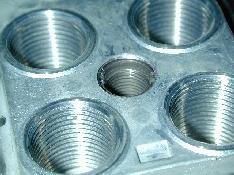| The Tool
Head:
In order to eliminate all tool head
movement with a clamp and avoid any modification to the RL 550B's frame,
it is necessary to use a modified tool head.
Here is a close-up image of the tool
head:

Take note of the hole in the center of
the tool head. In a stock part, there is a through-hole cast into the
part at this location. In version 1 of the clamp, this hole was to be
tapped directly for the clamp fastener. The reduction of fastener head
diameter to provide powder measure clearance required the selection of a
fastener with a shank diameter actually smaller than the existing hole.
This made tapping the hole directly impossible. At this point in the
process, I thought I was at a dead end.
But after some thought and a lot of
number crunching, I found a steel insert that could be inserted into the
existing hole without thinning the walls of the tool head excessively.
(Look at the underside of the stock part, and you will see that the part
was cast with voids to save material and possibly weight.)
|
|
As it works out, accommodating the smaller
fastener actually improves the design. Originally, the design called for a
course-threaded steel fastener due to the aluminum threads. Using the
steel insert offers several significant improvements:
1. It provides for steel on steel
contact between the fastener and threads which will improve both max
clamping strength and durability.
2. It allows for the replacement of
a damaged insert (not likely), rather than replacing the entire tool head,
and
3. It allows the use of a fastener
with a higher TPI (threads per inch) count which provides greater control
over clamping force.
Not many folks know, but that center hole
is not there by accident. There is actually a setup tool that can be used
as an insert to that hole to index the base to the tool head. In addition,
the tool can be used with a powder die body in station one to check shell plate/base
alignment to the tool head. Initially, I thought that this capability
would have to be sacrificed on the modified tool heads.
Fortunately, I have been able to design the
tool head modification in such a way that the tool can still be used with
the center index hole. In the current design specification, approximately
the lower 50% of the index hole is preserved with its stock diameter.
Thus, the indexing tool can still be inserted from the bottom of the tool
head for indexing. This removes the necessity to
maintain one unmodified tool head for setup purposes (not that many people
ever do such a setup anyway).
Next...
|
